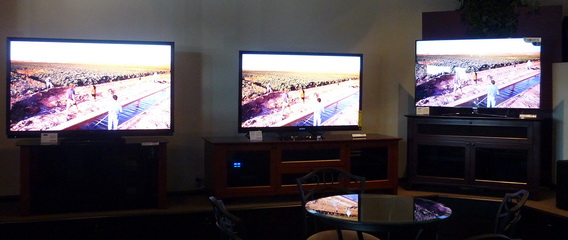First it was high-def and plasma, then it was 3D, and now it’s 4K and OLED. How do you know when it’s time to upgrade? This short guide will help you navigate the ins and outs of upgrading your system.
Get the Perfect Picture. First, you need to look at your TV. Does it have a few HDMI connections? If not, you have an older model that may not produce an HD image, and an upgrade is definitely in order to enjoy all the latest HDTV programming, Blu-ray movies, and games. Want a larger image? That’s another very good reason to upgrade your TV, and with prices on flat-panel TVs so affordable, it’s a good time to do it.
You also might be wondering if you should wait to upgrade to TV technologies such as ultra high definition TV/4K (which has four times the resolution as HDTV) and OLED (a technology that offers an extremely vivid image). The answer is maybe. These technologies, while very exciting, are not yet ready for prime time. OLED is very hard to produce at larger sizes and there is no consumer content available for ultra HD. Even if there was content available, the bandwidth needed to power the 4K content is a barrier to entry for broadcasters, making it unlikely that you’ll find any 4K channels on your cable/satellite service anytime soon. HDTV is here to stay—at least for the foreseeable future—the content is aplenty, and the image is amazing.
Cabling Considerations. Just because you have a new HDTV does not mean you are getting the best image. You need to use a high-quality HDMI cable for optimal results. The improvement using step-up cable can be dramatic; video artifacts are reduced and sound is audibly crisper. Some cable manufacturers even guarantee their HDMI cables for future technologies such as 4K. For the ultimate in future-proofing, purchase an HDMI cable with plenty of bandwidth. Many also now include Ethernet for connected devices.
Get Good Audio. If the sound coming from your TV just isn’t cutting it anymore, it’s time to consider upgrading. Nothing can beat a complete surround sound system for the “you are there” effect. For a surround system, you’ll definitely need a good A/V receiver for switching between sources and to process the audio. Make sure your new receiver has HDMI inputs and outputs and also look for room EQ—a great feature that optimizes each speaker to perform at its best in your room.
If you don’t want to put a surround system in your living room, there are now high-quality all-in-one sound bars that simulate surround sound and offer audio that’s typically better than that of your TV’s speakers. These all-in-one models don’t necessarily require a receiver to power and many can perform the HDMI switching needed for your HD sources. It’s important to be careful when choosing a sound bar because there are so many on the market; purchase only reputable brands.
Don’t Forget Protection. One of the biggest issues to consider when upgrading is planning on protection. This includes things like power protection that will keep your new equipment from shorting out during a power surge, along with comprehensive warranty and service plans should something go awry. All are nominal charges but can save you thousands on replaced equipment and service calls.
Get Connected. Finally, there is a world of content at your fingertips…all you need is an Internet connection and a device to stream the content. AppleTV, Roku, GoogleTV, and others all stream content instantaneously and are very inexpensive, offering true video-on-demand. You can even control your entire system with your smart phone or iPad. Come in, and we’ll show you how.

